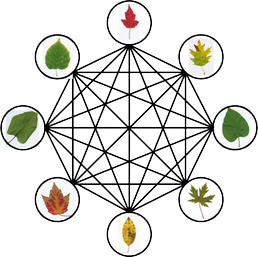Associative learning in ecosystems: Network level adaptation as an emergent propery of local selection
- Started
- 1st June 2013
- Ended
- 20th September 2013
- Research Team
- Daniel Power
- Investigators
- Richard Watson, James Dyke
Ecosystems may exhibit collective adaptive properties that arise from natural selection operating on their component species. These properties include the ability of the ecosystem to return to specific configurations of species, in a manner highly analogous to mechanisms of associative learning in neural networks. This “memory” enables the ecosystem to return to a previous species composition after ecological disruption that may temporarily, but drastically alter species levels. In addition, preferred configurations of species become more stable over time, making them more resistant to future evolutionary perturbations. The longer an ecosystem remains at a specific composition, the stronger this memory becomes.
An ecosystem of species competing at the same trophic level was modelled through Lotka- Volterra dynamics. Each species is considered to have a resource utilisation profile (RUP) that determines that species’ level of competition with others. Species with similar RUPs compete for similar niches and tend to competitively exclude each other. Mutant members of each species have altered RUPs such that they compete with other species slightly differently than their parent populations. A key feature of this model is that mutations that reduce a species’ competition with another species compensate by increasing competition with others such that for any one species, its net levels of competition with all other species do not change via mutation.
Preserved mutations are those that increase the recipient’s growth rate. These mutations will be those that increase cooperation between species that co-occur at the expense of decreasing cooperation between species that do not. The nature of these changes in the network is equivalent to the premise in neuroscience that memories form when “neurons that fire together, wire together”. It is creation of these associations that gives this ecosystem model the ability to return to specific species configurations after a disruption.
Ecosystem-level adaptation has often been rejected as implausible as selection cannot ‘choose between’ ecosystems. This project demonstrates a simple mechanism by which an ecosystem can exhibit system level adaptation that is dependent only on natural selection operating on its component species.
Categories
Life sciences simulation: Ecology, Evolution, Neuroscience
Socio-technological System simulation: Self Organized Networks
Algorithms and computational methods: Evolutionary Algorithms
Transdisciplinary tags: Complex Systems
